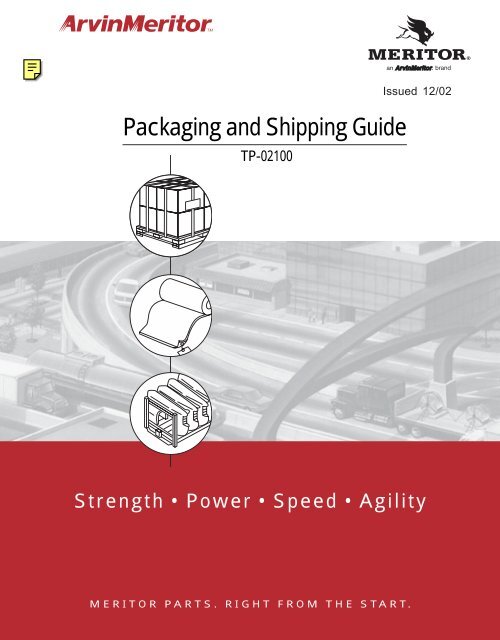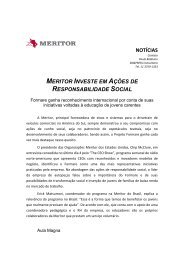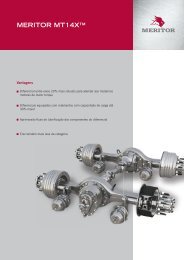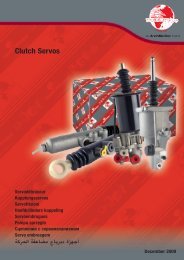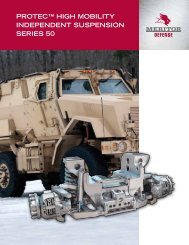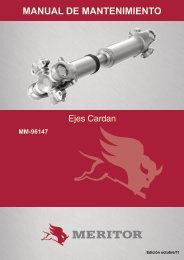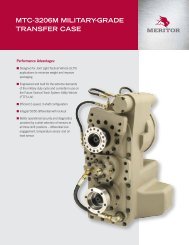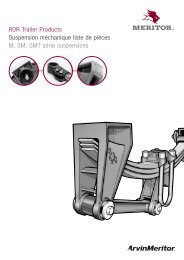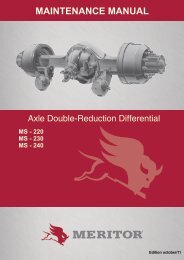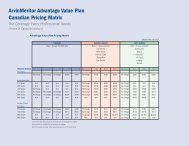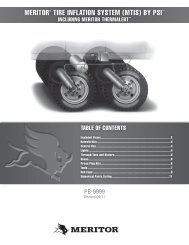CVA Packaging and Shipping Guide - Suppliers - Meritor
CVA Packaging and Shipping Guide - Suppliers - Meritor
CVA Packaging and Shipping Guide - Suppliers - Meritor
You also want an ePaper? Increase the reach of your titles
YUMPU automatically turns print PDFs into web optimized ePapers that Google loves.
<strong>Packaging</strong> <strong>and</strong> <strong>Shipping</strong> <strong>Guide</strong><br />
TP-02100<br />
Issued 12/02<br />
Strength • Power • Speed • Agility<br />
MERITOR PARTS. RIGHT FROM THE START.<br />
1
CONTENTS<br />
Introduction ........................................................................................................................... 2<br />
Compliance .......................................................................................................................... 3<br />
<strong>Packaging</strong> Responsibilities .................................................................................................. 3<br />
General <strong>Packaging</strong> Requirements ........................................................................................ 3<br />
<strong>Packaging</strong> Costs ............................................................................................................. 3<br />
<strong>Packaging</strong> Material .......................................................................................................... 4<br />
Ergonomics ..................................................................................................................... 4<br />
Unique <strong>Packaging</strong> Requirements.................................................................................... 4<br />
<strong>Shipping</strong> Container Specifications ....................................................................................... 4<br />
Manually-H<strong>and</strong>led Container Requirements ................................................................... 4<br />
Mechanically-H<strong>and</strong>led Container Requirements ............................................................ 5<br />
Container Height ............................................................................................................. 5<br />
Temperature .................................................................................................................... 5<br />
Moisture .......................................................................................................................... 5<br />
Rust Prevention .................................................................................................................... 5<br />
Packing Lists <strong>and</strong> Invoices ................................................................................................... 5<br />
Palletization of Products .......................................................................................................6<br />
General <strong>Guide</strong>lines ......................................................................................................... 6<br />
Wood Pallet Specifications ................................................................................................... 7<br />
Basic Pallet Requirements .............................................................................................. 7<br />
Pallet Load Arrangements .................................................................................................... 8<br />
Bar Coded <strong>Shipping</strong> Label Requirements ............................................................................ 8<br />
General ........................................................................................................................... 8<br />
Quality ............................................................................................................................. 9<br />
Label Size <strong>and</strong> Materials ................................................................................................. 9<br />
Label Information............................................................................................................. 9<br />
Bar Code Symbology .................................................................................................... 11<br />
Special Labels .............................................................................................................. 11<br />
Delivery Dates............................................................................................................... 11<br />
Advance <strong>Shipping</strong> Notices ............................................................................................ 12<br />
<strong>Shipping</strong> Information ..................................................................................................... 12<br />
1
Introduction<br />
This manual establishes quality st<strong>and</strong>ards <strong>and</strong> guidelines for Arvin<strong>Meritor</strong>’s Commercial Vehicle Aftermarket<br />
(ARM<strong>CVA</strong>) service parts packaging, labeling <strong>and</strong> shipping requirements.<br />
<strong>Suppliers</strong> are responsible for packaging <strong>and</strong> labeling service parts so that they arrive at Arvin<strong>Meritor</strong>’s Parts Distribution<br />
Centers <strong>and</strong> / or Arvin<strong>Meritor</strong>’s customers, in damage-free condition, with appropriate documentation. In<br />
addition, the supplier's responsibility to ensure packaging is in accordance with industry st<strong>and</strong>ards <strong>and</strong> does not<br />
create safety issues when h<strong>and</strong>led <strong>and</strong> transported.<br />
To become an integral part of Arvin<strong>Meritor</strong>’s efforts to strengthen its position in the automotive service parts<br />
business, the suppliers must underst<strong>and</strong> <strong>and</strong> comply with the st<strong>and</strong>ards in this guide.<br />
Following the requirements in this manual will assure high quality packaging by the Company’s suppliers. It will also<br />
help Arvin<strong>Meritor</strong> control costs <strong>and</strong> provide our customers with the best possible product.<br />
The contents of this manual are a part of the Terms <strong>and</strong> Conditions of the ARM purchase order as referenced in<br />
Section 3.7 of the SQSR manual.<br />
Questions regarding compliance, content, intent or recommendations for these requirements should be directed to:<br />
Arvin<strong>Meritor</strong> Commercial Vehicle Aftermarket<br />
7975 Dixie Highway<br />
Florence, Kentucky 41042<br />
Attn: Supplier Development Manager<br />
2
Compliance<br />
This manual contains the packaging st<strong>and</strong>ards for the Arvin<strong>Meritor</strong> Commercial Vehicle Aftermarket’s <strong>Meritor</strong><br />
Division. Compliance to this manual is required as directed in Section 3.7 of the Supplier Quality System Requirements<br />
(SQSR) Manual. Failure to conform to the requirements in this manual will be h<strong>and</strong>led as per section 3.10 of<br />
the SQSR, which states:<br />
A m<strong>and</strong>atory minimum charge of $100.00 USD (or equivalent) shall be imposed for the following.<br />
a) Nonconformance Report (e.g. DMN, QPR) or Non-Conforming Service.<br />
b) Non-Conforming Product Deviation Requests.<br />
c) PPAP Submission Rejections or shipments of unapproved product.<br />
d) Delivery Performance Failures (in addition to any actual costs associated with the failure).<br />
Some products may require special packaging or labeling not covered in this document. If this applies to your<br />
parts, contact Arvin<strong>Meritor</strong>’s Commercial Vehicle Aftermarket for assistance in the development of packaging<br />
specifications acceptable to both parties. Any deviation from the requirements in this manual must have prior<br />
written approval from Arvin<strong>Meritor</strong>. This deviation must be attached to each load shipped under the deviation.<br />
<strong>Packaging</strong> Responsibilities<br />
<strong>Suppliers</strong> are responsible for designing packaging<br />
that will safely deliver aftermarket parts <strong>and</strong> material<br />
to Arvin<strong>Meritor</strong> <strong>and</strong> / or the point-of-use in damage<br />
free condition, assuming normal h<strong>and</strong>ling <strong>and</strong> storage.<br />
The packaging must be designed taking into account<br />
the following functions:<br />
• Protection of the product from physical damage<br />
through the distribution chain<br />
• Convenience of use, safety, <strong>and</strong> ease of h<strong>and</strong>ling<br />
• Compliance with legal <strong>and</strong> regulatory requirements<br />
• Communication of information (labeling)<br />
• Separates “mixed loads” by part number, weight<br />
or size<br />
• Environmental acceptability <strong>and</strong> ease of reuse,<br />
recycling or disposal.<br />
• Conforms to the guidelines stated in this manual<br />
for: container packing, labeling, packing lists,<br />
pallet box carton <strong>and</strong> hazardous materials<br />
specifications.<br />
General <strong>Packaging</strong> Requirements<br />
<strong>Packaging</strong> Costs<br />
All part quotations are to include packaging <strong>and</strong><br />
labeling costs in the piece-part price. Separate<br />
dunnage charges are not acceptable unless prior<br />
written approval from Arvin<strong>Meritor</strong> is obtained due to<br />
the use of returnable containers. The supplier is<br />
responsible for packaging <strong>and</strong> labeling as required by<br />
this document including the cost of all materials <strong>and</strong><br />
labor.<br />
Vendors using returnable packaging MUST CLEARLY<br />
mark the vendor’s name <strong>and</strong> return location on the<br />
outside of each returnable packaging item. To assist<br />
in sorting <strong>and</strong> return, color-coding of the returnable<br />
packaging is recommended. Failure to properly<br />
identify returnable packaging will result in delays in<br />
returns <strong>and</strong> payment for returnables shipping into<br />
ARM<strong>CVA</strong> facilities.<br />
3
<strong>Packaging</strong> Material<br />
Recyclable materials must be used <strong>and</strong> packaging<br />
should consist of recycled materials when possible<br />
<strong>and</strong> cost effective.<br />
Plastic material must be labeled in accordance with<br />
the Society of Plastics Industry Recycling Symbology<br />
(see Exhibit A).<br />
Unique <strong>Packaging</strong> Requirements<br />
Unique packaging requirements such as weight,<br />
fragility, surface appearance, or coatings that are not<br />
covered by these guidelines are the responsibility of<br />
the supplier.<br />
<strong>Shipping</strong> Container<br />
Specifications<br />
Manually-H<strong>and</strong>led Container Requirements<br />
Gross weight must not exceed 50 pounds.<br />
Corrugated containers must display a Certificate of<br />
Box Manufacturer in a readily visible location on the<br />
container (see Exhibit B).<br />
The use of salvaged containers, pallets <strong>and</strong> other<br />
packaging material must have prior written approval<br />
from Arvin<strong>Meritor</strong>.<br />
Exhibit B<br />
Certificate of Box Manuafacturer<br />
Ergonomics<br />
All containers <strong>and</strong> packaging must be designed with<br />
consideration given to ease of h<strong>and</strong>ling <strong>and</strong> part<br />
removal. Appropriate consideration must be given to<br />
height restrictions, weight restrictions, carton disassembly<br />
<strong>and</strong> any other issues, which may affect<br />
worker safety. The supplier is responsible to ensure<br />
all material is packaged in such a way to ensure<br />
safety is maintained throughout the product distribution<br />
stream. The supplier must advise Arvin<strong>Meritor</strong>’s<br />
Commercial Vehicle Aftermarket if the requirements in<br />
this manual would negatively impact workplace<br />
safety, <strong>and</strong> recommend alternatives.<br />
Manually-H<strong>and</strong>led Container<br />
Corrugated cartons are the most common manuallyh<strong>and</strong>led<br />
containers, <strong>and</strong> are acceptable under the<br />
following requirements:<br />
• The container must be expendable.<br />
• Use a regular slotted carton except when other<br />
styles may be dictated by part characteristics.<br />
• The unsupported bottom of the carton must be<br />
able to hold the contents.<br />
• H<strong>and</strong>holds are desirable for bulky packages.<br />
• Packages should provide sufficient strength <strong>and</strong><br />
stability to withst<strong>and</strong> stacking of pallet loads two<br />
layers high, <strong>and</strong> insure parts arrive undamaged.<br />
• The package closure must prevent spilling of the<br />
contents <strong>and</strong> should not create a safety hazard<br />
during h<strong>and</strong>ling <strong>and</strong> opening. Metal fasteners or<br />
staples are not recommended.<br />
• Contents should reasonably fill the container with<br />
a minimum amount of void.<br />
4
Mechanically-H<strong>and</strong>led Container<br />
Requirements<br />
Gross Weight must not exceed 4,000 pounds.<br />
All shipments of mechanically h<strong>and</strong>led containers<br />
must be on wooden pallets or approved returnable<br />
containers. The wooden pallets must meet the basic<br />
pallet requirement specified in the Wood Pallet<br />
Specifications section of this document. Any<br />
deviation from this practice must have prior written<br />
authorization from ARM<strong>CVA</strong>.<br />
The one-year period will be initiated upon the date of<br />
first receipt at one of ARM<strong>CVA</strong>’s facilities. The rust<br />
free guidelines will be based on the supplier’s packaging<br />
of the product <strong>and</strong> will not be based on containers<br />
left open <strong>and</strong> in use at the distribution centers.<br />
Common rust preventative products that may be used<br />
include: volatile corrosion inhibitor (VCI) products,<br />
paint, <strong>and</strong> oil. All temporary coatings used by<br />
suppliers to assure parts remain rust free must be<br />
safe, easy to h<strong>and</strong>le, <strong>and</strong> environmentally friendly.<br />
Coatings must not affect part appearance or function.<br />
Metal parts shipped using wooden crates; pallets<br />
<strong>and</strong>/or dividers must have a VCI barrier between the<br />
part <strong>and</strong> the wood to protect the part from moisture<br />
absorbed by the wood.<br />
Manufacturing Specification Data Sheets (MSDS) of<br />
the rust inhibitor or VCI must be submitted/supplied to<br />
the receiving ARM<strong>CVA</strong> facility prior to the initial<br />
shipment of parts.<br />
Container Height<br />
Containers must not exceed 40” in height where part<br />
size allows. The exceptions to this rule are Hubs <strong>and</strong><br />
Drums which must not exceed 48" in overall height.<br />
The overall height is measured from the bottom of the<br />
pallet to the top of the highest point on the container.<br />
Temperature<br />
Expendable containers must be designed to withst<strong>and</strong><br />
temperature variations from -30° F to +150° F<br />
(-34.4° C to 65.6° C)<br />
Moisture<br />
Expendable containers must be designed to withst<strong>and</strong><br />
90% humidity at 150° F (65.6° C) exposure<br />
during transit <strong>and</strong> storage.<br />
Rust Prevention<br />
Mechanically-H<strong>and</strong>led Container<br />
ARM<strong>CVA</strong> is committed to providing our customers<br />
with high quality, low cost service parts. When our<br />
customers receive a service part from us, they<br />
expect it to be protected from damage <strong>and</strong> rust.<br />
Customer satisfaction needs to be the top priority for<br />
all of us as we move forward. For that reason, we<br />
are requiring that all metal parts shipped to<br />
Arvin<strong>Meritor</strong>’s Commercial Vehicle Aftermarket<br />
facilities be corrosion free upon receipt <strong>and</strong> must<br />
have a one year rust free shelf life. <strong>Suppliers</strong> will<br />
be responsible for treating <strong>and</strong> packaging all<br />
parts in such a manner as to keep them free of<br />
corrosion for the one year time period.<br />
5<br />
Packing Lists <strong>and</strong> Invoices<br />
It is imperative that all packing lists <strong>and</strong> invoices<br />
correctly describe the goods being shipped or billed.<br />
Part numbers on packing lists <strong>and</strong> invoices must<br />
exactly match the part numbers on the ARM<strong>CVA</strong><br />
material release <strong>and</strong> purchase order. Foreign suppliers<br />
must provide a detailed parts description in accordance<br />
with U.S. Customer Regulations.<br />
When shipping parts into any ARM<strong>CVA</strong> facility, at<br />
least two packing lists must be included with each<br />
shipment. One packing list must be attached to the<br />
Bill of Lading, <strong>and</strong> protected from damage or loss<br />
while in transit.<br />
A second packing list must be enclosed in one<br />
container that is clearly marked “PACKING LIST<br />
ENCLOSED.” When shipping full truckloads of<br />
material to any Arvin<strong>Meritor</strong> facility, the packing list<br />
must be clearly visible when the trailer door<br />
is opened.<br />
All packing lists <strong>and</strong> invoices must have the supplier<br />
name <strong>and</strong> code on each copy. Each packing list <strong>and</strong><br />
invoice may contain parts from no more than one<br />
purchase order. The packing lists <strong>and</strong> invoices must<br />
be legible <strong>and</strong> include all information below:<br />
1) Readily Identifiable Packing List Number.<br />
2) “Ship To” Location – This must be exactly as<br />
shown on the supplier release.<br />
3) “Bill To” Location – This must be exactly as<br />
shown on the supplier release.
4) <strong>Meritor</strong> Vendor Code.<br />
5) Release Number <strong>and</strong> Purchase Order Number.<br />
6) Contents – Define how many containers there<br />
are, the type(s) of containers <strong>and</strong> the number of<br />
packing lists. For example, “20 cartons, 2<br />
pallets, 8 packing lists”. Also, show the number<br />
of pieces or packages on pallets when shipping<br />
palletized material such as: “60 cartons on 3<br />
pallets”, “1 pallet of 30 cartons”, etc.<br />
7) Description – Part name as shown on the<br />
supplier release.<br />
8) Part Number Ordered – Part number exactly as<br />
shown on the supplier release.<br />
9) <strong>Meritor</strong> Part Number – If the supplier purchase<br />
order releases a vendor part number, <strong>and</strong> references<br />
a <strong>Meritor</strong> part number, the <strong>Meritor</strong> part<br />
number must be referenced on all documents.<br />
10) Quantity of part number ordered (by ARM<strong>CVA</strong>).<br />
11) The Quantity of Goods Shipped – The quantity<br />
must conform to the terms as ordered on the<br />
release form.<br />
12) Country of Origin Identification – All packing<br />
lists <strong>and</strong> invoices must be labeled with the<br />
country of origin that produces the part<br />
being shipped.<br />
3) For shipments of multiple palletized cartons or<br />
containers, each individual carton or container<br />
must be consecutively numbered <strong>and</strong> marked on<br />
the outside (i.e. 1 of 3, 2 of 3, 3 of 3). This will<br />
assist in identifying individual cartons that may<br />
get separated during shipment.<br />
Box or Carton<br />
Identical labels should be located on two adjacent<br />
sides. (Wrap around label acceptable.) The upper<br />
edges of the labels should be as high as possible<br />
up to 20" from the bottom of the carton.<br />
4) Each pallet should be fully used to its maximum<br />
overall height of 40” when determining full pallet<br />
quantities. This measures from the floor to the<br />
top of the pallet <strong>and</strong> should never be higher than<br />
40” (except as noted for Hubs <strong>and</strong> Drums).<br />
5) When shipping small loads, mixed pallets are<br />
acceptable provided that no one part number<br />
exceeds 50% of the specified pallet quantity.<br />
These loads MUST BE CLEARLY identified as<br />
“MIXED LOAD” using the AIAG format in<br />
Exhibit J on top of the pallet <strong>and</strong> on at least two<br />
adjacent sides.<br />
Palletization of Products<br />
It is the supplier’s responsibility to utilize the basic<br />
pallet requirements as detailed in the Wood Pallet<br />
Specifications section of this document. The supplier<br />
should always use the approved ARM<strong>CVA</strong> pallet<br />
specification, unless the part size <strong>and</strong> / or weight<br />
make it impossible. In this case, the supplier is<br />
responsible for developing a safe method of<br />
palletizing the product <strong>and</strong> must get advanced written<br />
approval from Arvin<strong>Meritor</strong>. All following shipments of<br />
these parts are to be palletized in the same manner.<br />
General Requirements<br />
1) All shipments with at least 50% of the total<br />
pallet quantity going to ARM<strong>CVA</strong> facilities should<br />
have only one (1) part number per pallet.<br />
2) Parts shipped in overpack containers must have<br />
at least two labels located on adjacent corners of<br />
the box.<br />
Cartons on Pallet<br />
One master label may be used as<br />
described or one mixed load label .<br />
6) Part numbers are not to be on more than one<br />
pallet load or fragmented when the quantity<br />
supplied is sufficient to make a full pallet load.<br />
7) When shipping to ARM<strong>CVA</strong>, mixed loads on the<br />
approved pallet specification may contain up to<br />
six different part numbers. Mixed loads are not<br />
acceptable on extended length shipping<br />
containers.<br />
6
8) Each “MIXED LOAD” pallet must have part<br />
content identification for quicker part<br />
identification <strong>and</strong> location. This may be obtained<br />
by using either content labels or pallet-packing<br />
list. The content labels or packing list must be<br />
placed on top of the pallet. When an overpack<br />
box is used in conjunction with packing lists, an<br />
additional packing list for that container must be<br />
enclosed in the box.<br />
e) Boxes, partitions, pads or inserts must<br />
physically separate parts on a mixed load.<br />
Roll<br />
Hang one tag 2" (51mm)<br />
from the end of<br />
the material.<br />
Rack<br />
Tag one visible piece near the<br />
top, or use a label holder.<br />
9) When shipping parts in mixed loads, the<br />
following requirements must be followed to avoid<br />
a h<strong>and</strong>ling <strong>and</strong> restacking charge.<br />
a) Heavy parts must not be placed on top of<br />
lighter weight parts.<br />
b) Loose parts must be segregated or contained<br />
so they will not shift <strong>and</strong> damage other<br />
components / packages.<br />
c) Part numbers with the highest quantity of<br />
pieces / containers must be placed on the<br />
bottom of the pallet unless they fall under the<br />
weight restriction above.<br />
Telescopic or Set-up Containers<br />
Identical labels should be located on two adjacent sides<br />
of the outer box. Some applications may also require<br />
d) Low quantity part numbers must be placed<br />
near the top of the pallet, unless they are<br />
too heavy.<br />
Bundle<br />
Identical tags should be located at each end.<br />
Wood Pallet Specifications<br />
Basic Pallet Requirements<br />
Unless authorized or requested by ARM<strong>CVA</strong> <strong>and</strong><br />
where part size permits, the basic pallet requirements<br />
must be adhered to. The basic pallet requirements for<br />
shipments into the ARM<strong>CVA</strong> <strong>Meritor</strong> facilities are:<br />
• 48" x 40" footprint.<br />
• Non-reversible wood construction.<br />
• Double-faced design.<br />
• Four-Way pallet entry.<br />
• Designed for multiple trips <strong>and</strong> h<strong>and</strong>ling.<br />
• Pallet boards <strong>and</strong> stringers must be free from<br />
cracks <strong>and</strong> large knots that could lead to<br />
pallet failure.<br />
In an effort to st<strong>and</strong>ardize pallets in our distribution<br />
centers, ARM<strong>CVA</strong> request that the supplier uses our<br />
approved pallet specification in Exhibit C (see page<br />
13). This approved specification meets the basic<br />
pallet requirements, but it is limited to loads of<br />
approximately 2000 pounds when placed into racks<br />
without decking. It is the supplier's responsibility to<br />
use a pallet appropriate for the size <strong>and</strong> weight of the<br />
parts supplied. If the supplier needs a heavier duty<br />
pallet, every effort should be made to adhere to the<br />
basic pallet requirements.<br />
If the part size exceeds the 48" x 40" footprint, the<br />
pallet should be constructed to accommodate the<br />
part length while maintaining the 40" width requirement.<br />
Any deviation from the basic pallet requirements<br />
will require prior written authorization from<br />
ARM<strong>CVA</strong>.<br />
7
Pallet Load Arrangements<br />
1) Maximum pallet height from the ground to the top<br />
is 40” high (except as noted).<br />
2) Overhang of material on pallets is unacceptable.<br />
Deck boards should support container corners.<br />
3) Loads secured to pallets using shrink or stretch<br />
wrap must use material of sufficient thickness to<br />
retain the load <strong>and</strong> to prevent load shift.<br />
4) Loads secured to pallets with strapping must use<br />
edge protectors to prevent straps from cutting<br />
into cartons.<br />
5) It is acceptable to mix different part numbers on<br />
a pallet only after full pallets of like part numbers<br />
have been completed. Exhibit D (see page 12)<br />
illustrates when it is acceptable to ship different<br />
part numbers on the same pallet.<br />
9) When stacking pallets, make sure any carton<br />
labeling information is facing the outside of the<br />
pallet so that part number information is readily<br />
visible.<br />
10) Place a wood divider between the pallet <strong>and</strong> the<br />
packages where the bottom layer of packaged<br />
parts have the potential to slip <strong>and</strong>/or deform into<br />
pallet slats.<br />
11) To minimize manual h<strong>and</strong>ling <strong>and</strong> to allow for<br />
stacking, all cartons must be “palletized” in<br />
individual layers on the pallet (See Exhibit E-1).<br />
12) The “pyramiding” of cartons is strictly prohibited<br />
(See Exhibit E-2)<br />
6) Acceptable mixed pallet loads must be identified<br />
as “MIXED LOAD” clearly on the pallet per<br />
previous instructions.<br />
7) When placing pallets in the carrier’s equipment,<br />
be sure that they cannot shift in transit. Also,<br />
whenever suitable, always double stack pallet<br />
loads within the truck <strong>and</strong> rail cars with load<br />
separators that distribute the weight of the top<br />
pallet evenly over the bottom. Excess pallet<br />
weights over 1000 lbs. must not be stacked on<br />
top of another pallet. In instances when pallet<br />
weight, strength or configuration prevents double<br />
stacking, the carrier must be alerted on the Bill of<br />
Lading with a note <strong>and</strong> a label placed on the<br />
pallet, reading “HEAVY LOAD DO NOT DOUBLE<br />
STACK PALLETS.” This label should be applied<br />
to all four faces of the finished load.<br />
8) This label is intended to direct the loading of a<br />
carrier’s equipment (trailer) <strong>and</strong> not necessarily<br />
for material h<strong>and</strong>ling practices within a<br />
supplier’s facility.<br />
8<br />
Bar Coded <strong>Shipping</strong> Label<br />
Requirements<br />
General<br />
These specifications, which apply to bar codes for<br />
shipping labels, were developed in conjunction with<br />
the AIAG Trading Partners Labels Implementation<br />
<strong>Guide</strong>line (AIAG: B-10)<br />
For more information on AIAG St<strong>and</strong>ards, contact the<br />
Automotive Industry Action Group, 26200 Lahser<br />
Road, Suite 200, Southfield, Michigan 48034.<br />
Exhibit F, Bar Coded <strong>Shipping</strong> Label<br />
PART NO.<br />
(P)<br />
QUANITY<br />
(Q)<br />
SUPPLIER<br />
(V)<br />
SERIAL<br />
(S)<br />
A28 3222D1954<br />
Part No. A28 3222D1954<br />
PART NO.<br />
(1P)<br />
25<br />
*25*<br />
R575DH<br />
R575DH<br />
A76543<br />
*A76543*<br />
ABC COMPANY FLORENCE, KENTUCKY 41042<br />
PURCHASE ORDER<br />
(K)<br />
LOT NO.<br />
(1T)<br />
S40864<br />
*S40864*<br />
ENG. REV.<br />
(2P)<br />
101 B
Quality<br />
The use of bar code systems is intended to increase<br />
productivity, reduce costs <strong>and</strong> improve data accuracy.<br />
An important aspect of any bar code system is that<br />
of quality. When labels cannot be decoded fast <strong>and</strong><br />
accurately, the advantages of bar coding are lost.<br />
Exhibit G, Bar Coded <strong>Shipping</strong> Tag<br />
<strong>Suppliers</strong> have the responsibility to provide bar code<br />
labels that meet the specification of this document<br />
<strong>and</strong> those of the Quality <strong>Guide</strong>line in Section 7 of<br />
AIAG B-10.<br />
Label Size <strong>and</strong> Materials<br />
Label dimensions should be in accordance with the<br />
dimensions shown in Exhibit H. Note: All exhibits<br />
are for illustrative purposes only <strong>and</strong> may not be to<br />
scale or bar code quality st<strong>and</strong>ards.<br />
The recommended label size is 4.0” high by 6.5” wide,<br />
which should cover most applications. Minimum label<br />
size shall be 4.0” high by 5.0” wide.<br />
Exhibit H-1, Label Dimensions<br />
1.2 in.<br />
30 mm<br />
Part No.<br />
(P)<br />
Part No.<br />
(P)<br />
2210E7441<br />
Part No. 2210E7441<br />
Quantity<br />
(Q)<br />
10<br />
Quantity 10<br />
Supplier<br />
(V)<br />
Serial<br />
(S)<br />
B04740C8<br />
B04740C8<br />
13524<br />
Serial 13524<br />
ABC Company, Florence, Kentucky 41042<br />
Part No.<br />
(1P)<br />
Purchase Order<br />
(K)<br />
Lot No.<br />
(1T)<br />
M20901<br />
Purchase Order M20901<br />
256<br />
Eng. Rev.<br />
(2P)<br />
D<br />
It is acceptable for the vendor to exceed the outside<br />
pallet label size if the vendor is incorporating the<br />
shipping information of shipped to <strong>and</strong> shipped from<br />
in the label. All other elements of the label must<br />
conform to the data requirements listed below.<br />
The label paper must be white with black printing.<br />
Adhesive labels can be pressure sensitive or dry<br />
gummed as long as adherence to the package<br />
substrate is assured. The application must be<br />
wrinkle-free, <strong>and</strong> for use on expendable<br />
packaging only.<br />
Exhibit H-2, Label Dimensions<br />
1.2 in.<br />
30 mm<br />
1.1 in.<br />
28 mm<br />
0.8 in.<br />
20 mm<br />
0.9 in.<br />
23 mm<br />
Part No.<br />
(P)<br />
Quantity<br />
(Q)<br />
Supplier<br />
(V)<br />
Serial<br />
(S)<br />
Part No.<br />
(1P)<br />
Purchase Order<br />
(K)<br />
Lot No.<br />
(1T)<br />
5.0 in.<br />
127 mm<br />
Eng. Rev.<br />
(2P)<br />
4.0 in.<br />
101 mm<br />
Do not place AIAG labels directly onto pre-packaged<br />
products that are ready for final sale to Arvin<strong>Meritor</strong>'s<br />
<strong>CVA</strong>'s customers.<br />
Label Information<br />
1) Data Areas <strong>and</strong> Titles – The part number,<br />
quantity, supplier number, serial number, purchase<br />
order <strong>and</strong> line number data must be<br />
displayed in both human readable characters <strong>and</strong><br />
bar code symbols (Reference Exhibit J)<br />
Exhibit J, Master Label<br />
1.1 in.<br />
28 mm<br />
0.8 in.<br />
20 mm<br />
Quantity<br />
(Q)<br />
Supplier<br />
(V)<br />
Part No.<br />
(1P)<br />
Purchase Order<br />
(K)<br />
4.0 in.<br />
101 mm<br />
PART NO.<br />
(P)<br />
Part No. 2258K1181<br />
QUANTITY<br />
(Q)<br />
PART NO.<br />
(1P)<br />
0.9 in.<br />
23 mm<br />
Serial<br />
(S)<br />
6.5 in.<br />
165 mm<br />
Lot No.<br />
(1T)<br />
Eng. Rev.<br />
(2P)<br />
Quantity 10<br />
SUPPLIER<br />
(V)<br />
SERIAL<br />
(4S)<br />
P0020111<br />
supplier VLE<br />
13524<br />
sERIAL 13524<br />
ABC Company, Florence, Kentucky 41042<br />
PURCHASE ORDER<br />
(K)<br />
LOT NO.<br />
(1T)<br />
648<br />
M20901<br />
pURCHASE oRDER m20901<br />
ENG. REV.<br />
(2P)<br />
C<br />
9
Each data area shall be separated by borderlines<br />
<strong>and</strong> shall contain the title <strong>and</strong> data identifier in the<br />
upper left h<strong>and</strong> corner.<br />
Titles <strong>and</strong> data identifiers shall be printed in 0.1”<br />
high letters.<br />
The supplier’s name, city, state <strong>and</strong> zip code<br />
shall appear at the bottom of the label, <strong>and</strong> shall<br />
be printed in 0.1” high letters.<br />
Bar code symbols shall be directly below the<br />
human readable data characters <strong>and</strong> shall be a<br />
minimum of 0.5” high.<br />
When the unit of measure is pieces, no notation<br />
is required. When the unit of measure is not<br />
pieces (i.e., pounds, feet, etc.), it shall be printed<br />
in human readable form only. When used, the<br />
unit measure abbreviation (Reference Exhibit L)<br />
shall be directly to the right of the human readable<br />
quantity.<br />
The unit of measure shall not be bar coded.<br />
6) Supplier Number – The supplier number will be<br />
the Vendor Code assigned by ARM<strong>CVA</strong> to each<br />
supplier location.<br />
2) Data Identifier Characters – A data identifier<br />
character shall be used to identify specific data.<br />
a) The data identifier shall be printed separately<br />
in human readable characters under the title.<br />
b) The data identifier shall not be included in the<br />
human readable characters.<br />
c) The data identifier shall be included in the bar<br />
code symbol.<br />
d) The data identifier characters are as follows:<br />
i) P – Part Number<br />
ii) 1P – Supplier Part Number<br />
iii) 2P – Engineering Revision Level<br />
iv) Q – Quantity Shipped<br />
v) V – Supplier Number<br />
vi) S – Unique Serial Number (SID)<br />
vii) 4S – Unique Serial Number (SID) –<br />
Master Load<br />
viii) 5S – Unique Serial Number (SID) –<br />
Mixed Load<br />
ix) K – Purchase Order Number<br />
x) 1T – Traceability number assigned to a<br />
unique batch or group of items (lot, heat,<br />
<strong>and</strong> batch) by the customer.<br />
3) Part Number - Part numbers shall be the same<br />
part numbers designated on the ARM<strong>CVA</strong><br />
purchase order or material release.<br />
The length of the part number bar code shall not<br />
exceed 5.5”<br />
4) Part Number Engineering Revision Level –<br />
The revision level the part was produced to must<br />
appear on the label.<br />
5) Quantity - The maximum number of characters<br />
for quantity is six (6) numeric characters.<br />
Exhibit K, Mixed Load Labels<br />
SUPPLIER<br />
(V)<br />
SERIAL<br />
(5S)<br />
MIXED<br />
LOAD<br />
MIXED<br />
LOAD<br />
SKY4<br />
SUPPLIER kdy4<br />
A76543<br />
serial A76543<br />
ABC Company, Florence, Kentucky 41042<br />
7) Serial Number (Shipment Identification<br />
Number) – The serial number shall be the<br />
Shipment Identification Number (SID). The SID<br />
is a unique number assigned by the supplier that<br />
specifically identifies a shipment. This number<br />
shall be referenced on invoices presented to<br />
ARM<strong>CVA</strong> for payment. In this way, each<br />
shipment will have a unique control number that<br />
differentiates it from other shipment for<br />
accounting purposes.<br />
Only one SID shall be used per shipment <strong>and</strong><br />
SID numbers shall not be repeated within any<br />
calendar year. The SID may be a maximum of<br />
nine (9) alphanumeric characters.<br />
<strong>Suppliers</strong> may use any convenient number (B/L,<br />
Work Order, Invoice Number, etc.) for the SID<br />
10
number if it conforms to the above guidelines <strong>and</strong><br />
is clearly identified as the SID on the packing list.<br />
For suppliers using Electronic Data Interchange<br />
(EDI), this SID must be the same SID used on<br />
advanced shipping notices <strong>and</strong> invoice transactions.<br />
8) Purchase Order – This refers to the ARM<strong>CVA</strong><br />
purchase order number.<br />
9) Lot Number – The lot number is a vendor<br />
supplied unique number that allows ARM<strong>CVA</strong> <strong>and</strong><br />
the vendor lot control <strong>and</strong> traceability. This is<br />
primarily for fasteners <strong>and</strong> heat-treated parts. By<br />
using the lot number, ARM<strong>CVA</strong> can assure there<br />
is not co-mingling of inventory.<br />
Bar Code Symbology<br />
Bar codes must be the 3-of-9 (Code 39) type as<br />
specified by the Automotive Industry Action Group<br />
(AIAG: B-10).<br />
individual package shall be identified with a<br />
separate bar code label.<br />
Delivery Dates<br />
1) The delivery date of record is dependent on what<br />
capabilities the supplier has. If a supplier has<br />
fully functional EDI <strong>and</strong> ASN capability that has<br />
been approved for use by Arvin<strong>Meritor</strong> <strong>CVA</strong>, their<br />
delivery date is tied to the ASN. The date that<br />
the material is shipped from these suppliers <strong>and</strong><br />
the ASN is received will be determined to be the<br />
delivery date.<br />
2) For suppliers without fully functional EDI / ASN<br />
capability or for those who have not met the<br />
Arvin<strong>Meritor</strong> <strong>CVA</strong> st<strong>and</strong>ards, the delivery date is<br />
the date the material is received on ARM<strong>CVA</strong>’s<br />
receiving dock.<br />
Exhibit D, Acceptable Mixed Pallot<br />
Loading Arrangement<br />
1) Code Configuration – The four (4) characters ($,<br />
/, +, %) of the 3-of-9 symbology shall not be used<br />
in the bar code labels.<br />
2) Code Density <strong>and</strong> Dimensions – The bar code<br />
heights must be a minimum of 0.5".<br />
For each bar code symbol, the average width of<br />
narrow elements shall be within the range of<br />
0.013" to 0.017".<br />
The ratio of the nominal width of the wide elements<br />
to the nominal width of the narrow elements<br />
shall be 3:1, with an allowable range of<br />
2.8:1 to 3.2:1.<br />
3) Check Digits – Check digits shall not be used in<br />
the bar codes.<br />
Special Labels<br />
Special labels may be required for multiple <strong>and</strong> mixed<br />
item shipments.<br />
1) Master Label – A Master Label, as shown in<br />
Exhibit J, shall be used when multiple packages<br />
of the same items are shipped together. The<br />
quantity listed on the Master Label shall be the<br />
total in all of the packages. Each individual<br />
package shall be identified with a separate bar<br />
code label.<br />
2) Mixed Load Label – A Mixed Load Label, as<br />
shown in Exhibit K, shall be used when packages<br />
of different items are shipped together. Each<br />
11<br />
3) The due date that appears on the material release<br />
is the date ARM<strong>CVA</strong> expects the full quantity of<br />
material released to be delivered per the delivery<br />
date outlined in 1 <strong>and</strong> 2 above.<br />
4) Early shipments will be considered for return to<br />
the seller if not authorized by the materialplanning<br />
department.
5) Both early <strong>and</strong> late shipments will negatively<br />
affect your supplier rating, which could preclude<br />
you from doing future business with Arvin<strong>Meritor</strong>.<br />
Advance <strong>Shipping</strong> Notices<br />
ARM<strong>CVA</strong> requires Advance-<strong>Shipping</strong> Notices (ASN)<br />
from all suppliers. The desired method is through<br />
Electronic Data Interchange (EDI). If the supplier has<br />
the capability to send EDI ASNs, please contact your<br />
ARM<strong>CVA</strong> buyer. The supplier will then be working<br />
with an IT representative from ARM<strong>CVA</strong> to assure<br />
the EDI/ASN formats are compatible with<br />
ARM<strong>CVA</strong>’s system.<br />
ARM<strong>CVA</strong> is investigating Web-based EDI systems<br />
that will enable all suppliers to meet the electronic<br />
ASN requirements. <strong>Suppliers</strong> that are currently not<br />
capable of EDI/ASN transmissions must arrange with<br />
their ARM<strong>CVA</strong> material planner to have the ASN’s<br />
faxed to the appropriate personnel.<br />
<strong>Shipping</strong> Information<br />
These shipping instructions apply to all shipments<br />
sold to ARM<strong>CVA</strong> <strong>and</strong> shipping to the receiving<br />
location designated on your weekly schedule /<br />
release.<br />
• To obtain the correct routing for each shipment,<br />
the vendor must call the ARM<strong>CVA</strong> Logistics<br />
Team at (859) 525-3490.<br />
• Shipments are to be made in accordance with the<br />
shipment routing instructions provided by the<br />
ARM<strong>CVA</strong> Logistics Team. The ARM<strong>CVA</strong><br />
Logistics Team MUST AUTHORIZE ALL<br />
EXCEPTIONS.<br />
• Any deviation from the routing supplied by the<br />
ARM<strong>CVA</strong> Logistics Team without authorization<br />
will result in ALL freight charges plus an<br />
administrative fee being DEBITED to the vendor.<br />
• Seller shall indemnify <strong>and</strong> hold buyer harmless<br />
from any loss, damage, cost, expense, or liability<br />
as a result of any failure by seller to observe<br />
these shipping instructions.<br />
• Seller shall be responsible for ALL additional<br />
charges for weekend <strong>and</strong> holiday pickups,<br />
canceled scheduled pickups, charges for loading<br />
delays at the shipping locations, <strong>and</strong> any other<br />
charges not covered by the contract rate of the<br />
Preferred Carrier.<br />
• Vendor must verify that the shipping label on<br />
each load has the correct shipping address. Any<br />
additional charges incurred by ARM<strong>CVA</strong> due to<br />
improper shipping addresses or vendor-supplied<br />
information will be charged back to the vendor.<br />
12
Exhibit C, Approved Pallet Specifications<br />
13
Exhibit L, Unit Of Measure Abbreviations<br />
Code Definition Code Definition Code Definition<br />
Distance Unit of Sale (Cont.) Unit of Sale (Cont.)<br />
DK Kilometers CP Crate PH Pack (PAK)<br />
MI Miles CQ Cartridge PK Package<br />
CR Cubic Meter PL Pallet/Unit Load<br />
CS Cassette PN Pounds Net<br />
Number of Units CT Carton PR Pair<br />
NB Barge CU Cup PT Pint<br />
NC Car CV Cover PW Pennywieght<br />
NL Load CW Hundred Pounds (CWT) QD Quarter Dozen<br />
NN Train CY Cubic Yards QR Quire<br />
NR Container CZ Combo QT Quart<br />
NT Trailer DC Disk (Disc) RD Rod<br />
NV Vehicle DE Deal RE Reel<br />
PC Piece DG Decigram RL Roll<br />
DM Decimeter RM Ream<br />
DR Drum SA S<strong>and</strong>wich<br />
Temperature DS Display SC Square Centimeter<br />
CE Centigrade, Celsius DZ Dozen ST Set<br />
FA Fahrenheit EA Each SF Square Foot<br />
KV Kelvin EV Envelope SG Segment<br />
FT Foot SH Sheet<br />
GA Gallon SI Square Inch<br />
Time GR Grain SL Sleeve<br />
DA Days GS Gross SM Square Meter<br />
HR Hours HD One-Half Dozen SO Spool<br />
LH Labor Hours HU Hundred SQ Square<br />
MO Months IN Inch SR Strip<br />
WK Weeks JB Jumbo SY Square Yard<br />
YR Years JO Joint TB Tube<br />
JR Jar TG Gross Ton<br />
KE Keg TH Thous<strong>and</strong><br />
Unit of Sale KG Kilogram TK Tank<br />
AM Ampoule KH Kilowatt, Hour TN Net Ton<br />
AY Assembly KT Kit TO Troy Ounce<br />
BA Bale LB Pound TY Tray<br />
BB Base Box LC Linear Centimeter UN Unit<br />
BC Bucket LF Linear Foot WH Wheel<br />
BD Bundle LG Long Ton YD Yard<br />
BE Beam LI Linear Inch ZZ Mutually Defined<br />
BF Board Feet LK Link<br />
BG Bag LM Linear Meter<br />
BH Brush LN Length Value<br />
BI Bar LO Lot CS Cost<br />
BK Book LP Liquid Pounds LS Lump Sum<br />
BL Block LT Liter MV Monetary Value<br />
BN Bulk LY Linear Yard<br />
BO Bottle MA Machine/Unit<br />
BR Barrel MC Microgram Volume<br />
BT Belt MG Metric Gross Ton DL Deciliter<br />
BU Bushel ML Milligram DM Dram<br />
BX Box MM Millimeter FO Fluid Ounce<br />
CA Case MN Metric Net Ton GA Gallon<br />
CB Carboy MR Meter LT Liter<br />
CC Cubic Centimeter MS Square Millimeter ML Milliliter<br />
CF Cubic Feet MT Metric Long Ton PT Pint<br />
CG Card MX Mixed QT Quart<br />
CH Container OL Ounce-Liquid<br />
CI Cubic Inches OZ Ounce AV<br />
CJ Cone PA Pail Other<br />
CK Connector PC Piece ZZ Mutually Defined<br />
CL Cylinder PD Pad<br />
CM Centimeter PE Pounds Equivalent<br />
CN Can PF Pallet (Lift)<br />
CO Coil PG Pounds Gross<br />
14
NOTES<br />
15
NOTES<br />
16
<strong>Meritor</strong> Heavy Vehicle Systems, LLC<br />
7975 Dixie Highway<br />
Florence, KY 41042 USA<br />
1-800-725-9355<br />
www.arvinmeritor.com<br />
© Copyright 2002<br />
Arvin<strong>Meritor</strong>, Inc.<br />
Litho in U.S.A.<br />
Issued 12-02<br />
TP-02100


